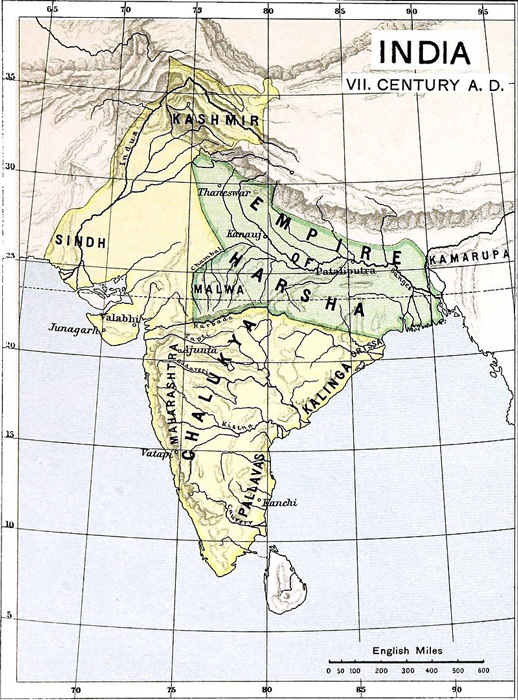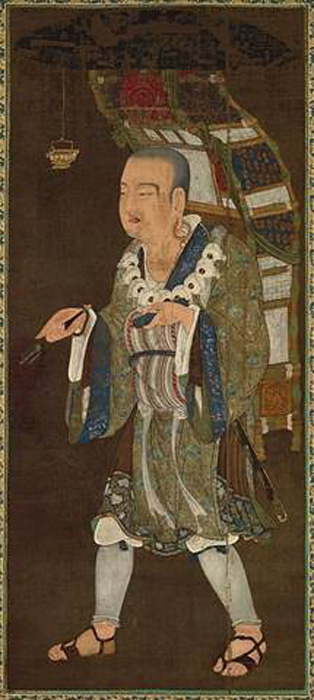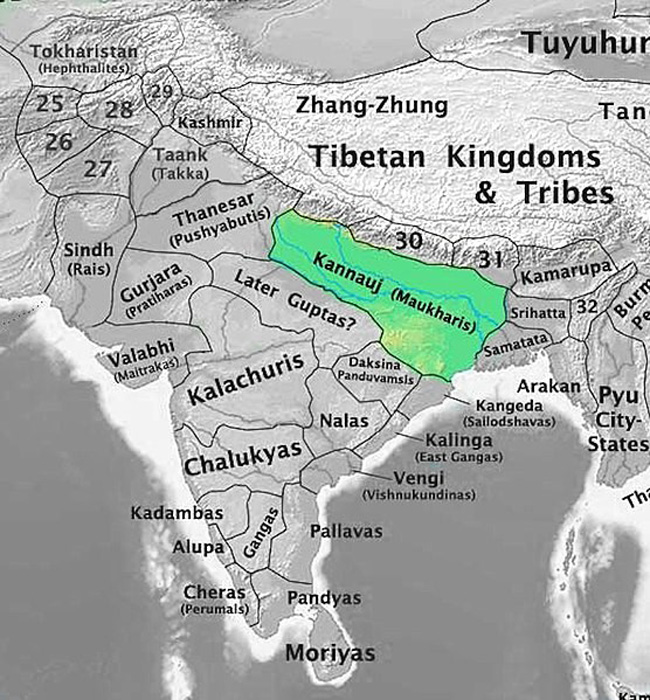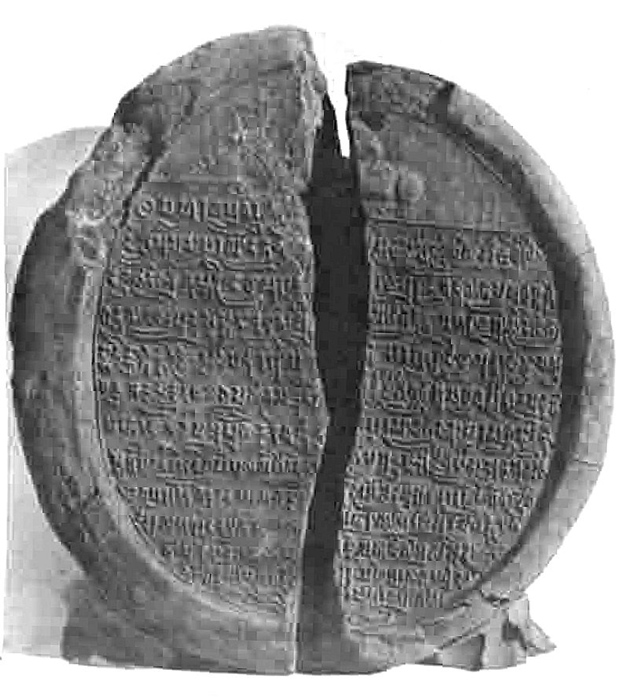In the pages of Indian history lie tales of many forgotten dynasties. Many kings and queens have ruled this rich land, and some dynasties have been greatly famous, while some have been forgotten.
One such forgotten Indian dynasty is that of the Pushyabhuti. Once great and wealthy rulers and builders, much of what they created has now been forgotten and lost. But the evidence of this forgotten era can still be seen, with the dynasty of Pushyabhuti enduring through dilapidated monuments of this forgotten era.
Rising from the ruins of the grand (and much more well known) Gupta Empire, the Pushyabhuti Dynasty ruled a large part of modern India from 500 AD. Ruling over most of northern India, the Pushyabhuti dynasty also went by the name of the Vardhana clan.
The kingdom of the Pushyabhuti dynasty was at its peak of grandeur during the rule of its greatest, and last, ruler, Harshavardhana. Ruling from his new capital of Kanyakubja, today known as Kanauj in Uttar Pradesh, he died childless in 647 AD, and his lineage died with him.
Today, the old capital of the Vardhana dynasty is known as Thanesar. Before Harshvardhana’s move, this was the political and administrative center of the Pushyabhuti dynasty, called Sthanisvara or Thaneswara and located in present-day Haryana and adjacent areas of the Punjab.
A Brief but Gloried Empire
The rise of the Pushyabhuti dynasty was fast but short-lived. From the ruins of the collapse of the Guptas, a small client king of the successor Maukhari dynasty carved out an empire through judicious marriage and open warfare.

After the fall of the Gupta Empire, only a few major powers remained in India. The Chalukyas and Pallavas ruled in the south. In the east, the Later Guptas ruled, and the Pushyabhuti dynasty was the sole epicentre of power for many years in the north. During their golden period, Pushyabhutis achieved many notable feats.
Although the Pushyabhuti dynasty ruled the north of India for quite some time, the early rulers did not command prominence in history. In fact, surprisingly little is known about these early kings, and the origin of their initial capital at Sthanishvara is also unknown.
Early inscriptions about the Pushyabhuti dynasty reveal that a king named Pushyabhuti may have established the kingdom. Other notable kings of the dynasty are Prabhakarvardhan, Naravardhana and Rajyavardhana.
These early kings of the Pushyabhuti dynasty ruled from 500 AD to 580 AD. Initially, the kingdom of Pushyabhutis was a feudatory of the Hun dynasty, as well as the Maukharis during this time. Jostled by powerful neighbors, it seemed unlikely that they would go on to greatness.
By the time of Harshavardhana however, only the seventh in the line, it had somehow reached the peak of power, rising to dominate other regional kingdoms. Kanauj was cemented as a power center for successive dynasties in the centuries to come.
Unrecorded and Unknown
The reason that the Pushyabhuti dynasty is not well known today lies in the fact that there are very few written accounts about their kings and kingdom. Only a few inscriptions dating back to the era of Pushyabhuti rule remain.
However, there are two reliable written sources which have survived, which can help us know more about this bygone era. One such book is the written account of Chinese traveller Hiuen Tsang.

Hiuen Tsang was a Chinese monk and scholar who visited India in the 7th century AD. His visit coincided with the rule of Harshavardhana. Thus, from the memoirs of Hiuen Tsang, a lot can be known about the Pushyabhuti kingdom.
The monk’s account describes the lifestyle and culture of the people living in the kingdom of Harsha, as it was known under this last ruler. The book also describes the details of Harshavardhana’s court and palace. The memoir also includes insights on religious sentiments and the social hierarchy prevalent in that time.
According to this account, Harsha’s kingdom was cosmopolitan, tolerant of religion (Harsha’s own brother was said to have differing beliefs to the ruler) and peaceful. Harsha’s uniting of the northern clans of India was largely with their assent, which led to a peaceful transition and rule.
Another solid source about the elaborate history of the Pushyabhuti dynasty is in the form of Harshacharita, the biography of Harshavardhana by his court poet, Banabhatta. This work captures the royal life of the most successful king of the dynasty, as well as segments on the other kings and princes of the Pushyabhuti dynasty.
The History of the Pushyabhutis
In the book the poet describes Prabhakarvardhan, the fifth king of the dynasty, as a proud man with many, often warlike, ambitions. Prabhakarvardhan’s bellicose nature was fortunate in its timing, and he expanded the kingdom of Pushyabhutis.

The king took the title of Maharajadhiraja, the first Pushyabhuti king to do so. He came to dominate over the Maukhari in neighboring regions and later entered a marriage pact, marrying his daughter, princess Rajyashri to the Maukhari king Grahavarman. Under the rule of Prabhakarvardhan, the Pushyabhuti dynasty grew in power.
His elder son Rajyavardhan succeeded Prabhakarvardhan in the early years of the 7th century. Rajyavardhan was a great warrior, according to Banabhatta, who found himself surrounded by the rival powers of the Later Guptas and Goudas.
- Pietrabbondante: One of the Last Samnite Sanctuaries
- Vimanas, The Hindu Machines: Did Ancient India Have Flying Saucers?
The Later Guptas, remnant heirs of the Gupta Empire, killed his brother Grahavarman and captured his sister Rajyashri. Meeting them in battle, Rajyavardhan defeated their army and even killed the leader of Later Guptas.
However, his victory was short lived. After only about a year on the throne, Shashanka, an ally of the Later Guptas, killed him with deceit. His younger brother Harshavardhan ascended to the Pushyabhuti throne.
Harshhavardhana
After the death of Rajyavardhan, Shashanka captured Kanyakubja, at that point the capital of Maukharis. Harshavardhana swore revenge for his brother’s murder and sister’s capture.
Forming an alliance with another regional king, Bhaskaravarman of the Kamarupa, he then marched on to war against Shashanka. The allied kings defeated the Malwa army of the Later Guptas, and frightened Shashanka into surrender.
The Pushyabhuti king then went on to rescue his sister from captivity and occupy Kanyakubja. At first, Harshavardhan administered the territory of Kanyakubja in the name of his sister. Later on, the king ascended the throne of the territory and made it the new capital of his expanded kingdom.
Harshavardhan was thus the king who unified Maukharis and Pushybhutis into a single clan, creating a huge kingdom in the process. He also assumed the title of Maharajadhiraja.
Harsha continued to fight against other regional kingdoms to expand his kingdom. After an unsuccessful war with the Vatapi kingdom stymied his ambitions to the south, he turned instead to the the east and west.

But it was not to last. After some 40 years of rule, the Pushyabhuti line of kings died with Harshavardhana because the illustrious king did not have an heir. After Harsha’s death, the Pushyabhuti empire slowly disintegrated and lost its glory.
Regional kings took over the empire’s territories, and the kingdom lost its existence with time. Today, Harshavardhan and his dynasty of Pushyabhutis retain only a weak shadow of their regality in history books, lost from the historical record and forgotten in human memory.
Top Image: The Pushyabhuti dynasty is almost forgotten today. Source: Brad Pict / Adobe Stock.
By Bipin Dimri